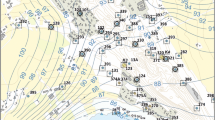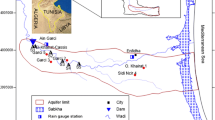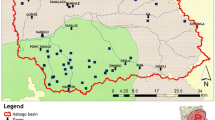Abstract
To cope with the general reduction of water availability and increase the subsurface storage of high-quality surficial waters, an artificial recharge project is ongoing in northern Italy within the WARBO LIFE+ Project funded by EU. WARBO is aimed at implementing large-scale use of artificial recharge in Italy where water directives still strongly limit its application. In this context, the Mereto recharge site was selected in the upper Fruili plain where the water availability is guaranteed during winter period by the Tagliamento and Ledra Rivers. An infiltration basin, about 5.5 m deep and 45 × 7 m2 wide, was built at Mereto in the early 2000s but the possibility of implementing the recharge has been allowed only very recently. The site is characterized by an elevation of 105 m asl and the depth to the groundwater table averages 50 m. Below a few meter-thick organic soil, the aquifer is composed by coarse deposits with an estimated thickness of 100 m and an average vertical hydraulic conductivity on the order of 10−4 m/s. A ~0.1 m3/s infiltration flow has been preliminary estimated (corresponding to an infiltration rate of 60 cm/h). Geophysical investigations (electrical resistivity tomography, high-resolution seismic surveys) together with infiltration and pumping tests have been carried out to characterize the vadose zone and the unconfined aquifer in the study area. Functional approaches and three-dimensional (3D) Finite Element numerical computations have been used to predict the effect of the artificial recharge. The results of these investigations will greatly reduce the hydrogeological knowledge gaps and will be used to fine tune the recharge program and to define the monitoring concept. This contribution aims to provide a methodology for the implementation of managed aquifer recharge programs using existing structures.












Similar content being viewed by others
References
Antonelli R, Stefanini S (1982) Nuovi contributi idrogeologici ed idrochimici sugli acquiferi dell’alta pianura veronese. Mem Sc Geol 35:35–67
Associazione Geotecnica Italiana (1977) Raccomandazioni sulla programmazione ed esecuzione delle indagini geotecniche. AGI, pp 1–93
Bouri S, Dhia HB (2010) A thirty-year artificial recharge experiment in a coastal aquifer in an arid zone: the Teboulba aquifer system (Tunisian Sahel). Comptes Rendus Geosci 342(1):60–74
Bouwer H (2002) Artificial recharge of groundwater: hydrogeology and engineering. Hydrogeol J 10:121–142
Chaieb H, Moncef R, Ouerfelli N, Laghi M, Magagnini L, Tosatto O, De Angelis A, Sollazzo F, Teatini P (2013), On the effectiveness of reusing treated wastewater by infiltration ponds in coastal farmlands. Preliminary investigation on insights from the Korba site, Tunisia. In: 1st CIGR Inter-Regional Conference on Land and Water Challenges, Paper no S7–8
Civita M (2005) Parere tecnico sul ravvenamento dell’acquifero libero nei Comuni di Lestizza, Pozzuolo del Friuli, Mereto di Tomba (UD). Consorzio di Bonifica Ledra, Tagliamento
Consorzio di Bonifica Ledra-Tagliamento (1982) Studio per la determinazione del bilancio idrologico dell’alta pianura friulana compresa tra i fiumi Isonzo e Tagliamento. Relazione. Technical Report, Udine
Cucchi F, Giorgetti F, Gemiti F, Massari G, Oberti S (1999) Caratterizzazione geochimica delle falde acquifere della pianura friulana. In: Acque sotterranee: Risorsa invisibile, Atti della giornata mondiale dell’acqua, Roma, 23 marzo 1998, Publ. CNR, GNDCI no 1955
Dal Prà A, Fabbri P, Bellenghi G (1989) Esempi di sfruttamento delle falde artesiane nella media pianura veneta in aree non servite da acquedotti pubblici. Modalità di utilizzazione, quantità dei prelievi, vantaggi ed effetti negativi. Mem Sc Geol 41:115–130
Della Vedova B, Nicolich R, Castelli E, Cimolino A, Barison E (2009) The geothermal potential of the carbonatic platform buried beneath the Veneto and the Friuli coastal areas: results from the Grado-1 borehole (NE Italy). Epitome Geoitalia 2009(3):141
Dragoni W (1998) Some considerations on climatic changes, water resources and water needs in the Italian region south of the 43°N. In: Issar A, Brown N (eds) Water, environment and society in times of climatic change. Kluwer Publications, Dordrecht, pp 241–271
Feruglio E (1925) La zona delle risorgive del Basso Friuli fra il Tagliamento e la Torre. Ann Staz Chim Agr Sperim Udine, serie 3, p 1
Florineth D, Schlüchter C (1998) Reconstructing Last Glacial Maximum ice surface geometry and flowlines in the central Swiss Alps. Eclogae Geol Helv 91:391–407
Florineth D, Schlüchter C (2000) Alpine evidence for atmospheric circulation patterns in Europe during the Last Glacial Maximum. Quatern Res 54:295–308
Fontana A (2006) Evoluzione geomorfologica della bassa pianura friulana. Pubbl N 47, Edizioni del Museo Friulano di Storia Naturale
Giuffrida A, Conte M (1990) L’evoluzione a lungo termine del clima italiano. Le Variazioni Recenti del Clima (1800–1990) e le Prospettive per il XXI Secolo. Mem Soc Geograf It, XLVI:329–342
Green WH, Ampt GA (1911) Studies on soil physics. J Agric Sci 4(1):1–24
Hazen A (1892) Some physical properties of sands and gravels, with special reference to their use in filtration. In: 24th Annual Report, Massachusetts State Board of Health, Pub Doc No 34, pp 539–556
Hazen A (1911) Discussion of ‘Dams on sand foundations’ by AC Koenig. Trans Am Soc Civ Eng 73:199–203
ISPRA (2010) Archivio Nazionale delle Indagini del Sottosuolo, http://sgi2.isprambiente.it/indagini/scheda_indagine.asp?Codice=161664
Kitanidis PK (1997) Introduction to geostatistics: applications in hydrogeology. Cambridge University Press, Cambridge
Kivimäki AL, Lahti K, Hatva T, Tuominen SM, Miettinen IT (1998) Removal of organic matter during bank filtration. In: Peters JH et al (eds) Artificial recharge of groundwater. Balkema Publishing, Rotterdam, pp 107–112
Krijgsmann B, Lobo Ferreira JPC (2001) A Methodology for Delineating Wellhead Protection Areas. Laboratorio Nacional de Engenharia Civil, Informacao Tecnica de Hidraulica, Lisboa, INCH 7, ISBN 972-49-1882-3
Logan J (1964) Estimating transmissibility from routine production tests of water wells. Groundwater 2:35–37
Martelli G, Granati C (2007a) Lithostratigraphical and hydrogeological characteristics of the aquifers of the low Friuli plain and sustainability of groundwater extractions. Mem Descr Carta Geol d’Italia LXXVI:241–266
Martelli G, Granati C (2007b) Valutazione della ricarica del sistema acquifero della bassa pianura friulana. Giornale Di Geologia Applicata 5:89–114
Martelli G, Granati C (2010) A comprehensive hydrogeological view of the Friuli alluvial plain by means of a multi-annual quantitative and qualitative research survey. Mem Descr Carta Geol d’Italia XC:181–208
Martelli G, Granati C, Rossi S (2004) The multistrata aquifer system in the low Friuli Plain (NE Italy). Proc ISES. Istanbul, Turkey, pp 267–274
Massmann JW, Butchart C, Stolar S (2003) Infiltration Characteristics, Performance, and Design of Stormwater Facilities. Final Research Report, Research Project T1803, Task 12. Washington State Department of Transportation, Olympia, Washington
Matthess G, Ubell K (1983) Lehrbuch der Hydrogeologie. Allgemeine Hydrologie, Grundwasserhaushalt, vol 1. Gebrüder Borntraeger, Berlin
Olsthoorn TN, Mosch MJM (2002) Fifty years artificial recharge in the Amsterdam dune area. In: Dillion PJ (ed) Management of aquifer recharge for sustainability, Proceedings of the 4th International Symposium on Artificial Recharge. Balkema Publishing, Rotterdam, pp 29–33
Orombelli G, Ravazzi C (1996) The late glacial and early Holocene: chronology and paleoclimate. Il Quat 9(2):439–444
Paniconi C, Putti M (1994) A comparison of Picard and Newton iteration in the numerical simulation of multidimensional variably saturated flow problems. Water Resour Res 30(12):3357–3374
Peters JH (1995) Artificial recharge and water supply in the Netherlands, state of the arts and future trends. In: Johnson AI, Pyne RDG (eds) Artificial recharge of ground water II. ASCE Publishing, New York
Philip JR (1969) Theory of infiltration. Adv Hydrosci 5:215–296
Putti M, Paniconi C (1995) Picard and Newton linearization for the coupled model of saltwater intrusion in aquifer. Adv Water Resour 18(3):159–170
Regione Autonoma Friuli-Venezia Giulia (2004) Carta del sottosuolo della Pianura Friulana. Litografia Artistica Cartografica, Firenze
Regione Emilia-Romagna, ENI-AGIP (1998) Riserve idriche sotterranee della Regione Emilia-Romagna. SELCA Publishing, Firenze (IT)
Regione Lombardia, ENI-AGIP (2002) Geology of the Po plain aquifers in the Lombardy region. SELCA Publishing, Firenze (IT)
Samadder RK, Kumar S, Gupta RP (2011) Paleochannels and their potential for artificial groundwater recharge in the western Ganga plains. J Hydrol 400:154–164
Sanchez-Vila X, Armenter JL, Ortuño F, Queralt E, Fernandez-Garcia D (2012) Managed artificial recharge in the Llobregat aquifers: quantitative versus qualitative aspects. In: The Llobregat: The Story of a Polluted Mediterranean River, Hdb Env Chem, Springer, Berlin, pp 51–68
Schaap MG, Leij FJ, van Genuchten MTh (1998) Neural network analysis for hierarchical prediction of soil water retention and saturated hydraulic conductivity. Soil Sci Soc Am J 62:847–855
Sheng Z (2005) An aquifer storage and recovery system with reclaimed wastewater to preserve native groundwater resources in El Paso, Texas. J Environ Manag 75(4):367–377
Stefanini S, Cucchi F (1977) Gli acquiferi nel sottosuolo della Provincia di Udine (Friuli-Venezia Giulia). Quaderni IRSA 34(6):131–147
Taroni G, Carbognin L, Pianetti F (1998) Analisi statistica della pluviometria tra Brenta e Piave. Atti dell’Istituto Veneto di Scienze, Lettere ed Arti—Cl. Sc. Fisiche, vol 157/2, pp 345–360
Tersigni S, Sappa G, Ramberti S, Coviello MT (2010) Considerations on the state of public water supply in ltaly. Giornale Di Geologia Applicata 15:5–15
Todd DK (1980) Groundwater hydrology. Wiley, New York
USEPA (1994) Ground water and wellhead protection handbook. EPA/625/R-94/001. Office of Ground Water Protection, Washington DC, p 270
van Genuchten MT (1980) A closed form equation for predicting the hydraulic conductivity of unsaturated soils. Soil Sci Soc Am J 44:892–898
Wyssling L (1979) Eine neue Formel zur Berechnung der Zuströmdauer des Grundwassers zu einem Grundwasserpumpwerk. Eclogae Geol Helv 72:401–406
Zuppi GM (2007) How do deep saline groundwater work in the Mediterranean coastal plains. Epitome Geoitalia 2:179
Acknowledgments
The study was funded by the EU LIFE + Project “WATER RE-BORN—Artificial Recharge: Innovative Technologies for the Sustainable Management of Water Resources”. The authors gratefully acknowledge the well drilling company Botti Elio S.a.s. (Adria, Italy), the personnel of the Consorzio di Bonifica Ledra-Tagliamento, particularly Massimo Canali and Stefano Bongiovanni, for the assistance in the field, together with Giorgio Mattassi and Davide Brandolin, ARPA Friuli Venezia Giulia (Palmanova, Italy), for their fruitful support to the project.
Author information
Authors and Affiliations
Corresponding author
Rights and permissions
About this article
Cite this article
Teatini, P., Comerlati, A., Carvalho, T. et al. Artificial recharge of the phreatic aquifer in the upper Friuli plain, Italy, by a large infiltration basin. Environ Earth Sci 73, 2579–2593 (2015). https://doi.org/10.1007/s12665-014-3207-8
Received:
Accepted:
Published:
Issue Date:
DOI: https://doi.org/10.1007/s12665-014-3207-8




